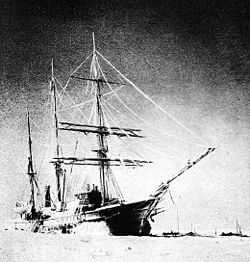Fyodor Matisen

Fyodor Andreyevich Matisen (Russian: Фёдор Андреевич Матисен) (June 1 (O.S. May 20), 1872, Saint Petersburg — December 19, 1921, Irkutsk) was a lieutenant of the Russian Imperial Navy, hydrographer, and explorer.
The Russian Polar Expedition (1900–1903)
He became the captain of Polar ship Zarya during the last part of Baron Eduard Toll's expedition on behalf of the Russian Academy of Sciences, the Russian Polar Expedition (1900–1903). The expedition began with Lieutenant Nikolai Kolomeitsev as commander of the ship. Fyodor Andreyevich Matisen was senior officer and second-in-command. Matisen already had experience in Arctic exploration, for he had previously taken part in an expedition to Svalbard. Alexander Kolchak accompanied the expedition as third naval officer and hydrographer. All these officers were from military background.
During the first wintering of Zarya close to Taymyr Island, the disagreements between Toll and Kolomeitsev became unsurmountable.[1] Finally Eduard Toll sent Kolomeitsev away on a long sledge trip overland with the mission of organizing coal depots for the ship. When the former captain was gone Matisen was appointed by Toll as Zarya's commander.
In March, while Zarya was still stuck in ice, Matisen explored the Nordenskiöld Archipelago on dogsled through the frozen sea as far as Russky Island. From there he swung SW, then south through another region of the large archipelago. On this trip Matisen could only survey parts of the coastlines of many of the Nordenskiöld islands, but on a subsequent trip in April he was able to make corrections to this survey by determining with accuracy the coordinates of at least one island in each of the groups in which he divided the archipelago. In total Matisen discovered and named about 40 islands of the Nordenskiöld Archipelago; he also arranged the archipelago into the following four main groups: Vilkitsky Islands, Pakhtusov Islands, Tsivolko Islands and Litke Islands.
After the thaw, Matisen led Zarya across the Laptev Sea to the New Siberian Islands. The aim of Toll's expedition was to explore well the area north of the New Siberian Islands and eventually sail towards the Pole in order to find the elusive Sannikov Land.
However, Zarya was trapped in fast ice and was unlikely to be freed that winter. Leaving the ship, Eduard Toll and three companions went in search of Sannikov Land on foot and kayaks. They vanished in November 1902 while travelling away from Bennett Island towards the south on loose ice floes. The Zarya was able to set sail only on 11 August 1902; it headed straight towards Bennett Island but was unable to approach the island on account of the ice. Finally Captain Matisen abandoned the attempt and sailed towards the Lena river delta..[2] Baron Eduard Toll and his party were never found.
Despite this tragedy, the expedition was not a failure. Many important oceanographic investigations were carried out, so that the study of data continued till 1917 and remained uncompleted. Besides, the Expedition plotted about 200 new geographical names on the map of the Arctic region.[3]
Commander Matisen left a badly leaking Zarya to sink at Tiksi Bay, close to the Lena delta. On 6 August 1903, after forwarding all scientific equipment to Saint Petersburg, the ship was stripped and its hull was allowed to fill with water. Matisen lowered the flag of the Neva Yacht Club for the last time and left Zarya. Matisen returned to Yakutsk on board ship Lena with Captain Yershevskiy. Apparently Zarya's remains still lie close to Brusneva Island at Bukhta Tiksi.
Posthumous honors

One of the two major channels separating the groups of the Nordenskiöld Archipelago has been named "Matisen Strait" (the other one is named after Lenin).[4] A "Dmitriy Ovtsyn" class coastal survey ship was named Fyodor Matisen by the USSR government in 1976.[5]
See also
- Zarya (polar ship)
- Nikolai Nikolaevich Kolomeitsev
References
- ↑ E. Toll. Die Russische Polarfahrt der Sarja 1900-1902 aus den hinterlassenen Tagebüchern von Baron Eduard Von Toll. Berlin 1909
- ↑
- ↑ V. Sinyukov, The contribution of the Russian polar expedition (1900 – 1903) in oceanographic investigation of the Arctic Seas of Russia. S. I. Vavilov Institute of the History of Science and Technology of the Russian Academy of Sciences, Moscow, Russia
- ↑ http://www.arcop.fi/reports/D11b.pdf
- ↑
- William Barr, Baron Eduard von Toll's Last Expedition: The Russian Polar Expedition, 1900-1903
- V. Sinyukov, The contribution of the Russian polar expedition (1900 – 1903) in oceanographic investigation of the Arctic Seas of Russia. S. I. Vavilov Institute of the History of Science and Technology of the Russian Academy of Sciences, Moscow, Russia